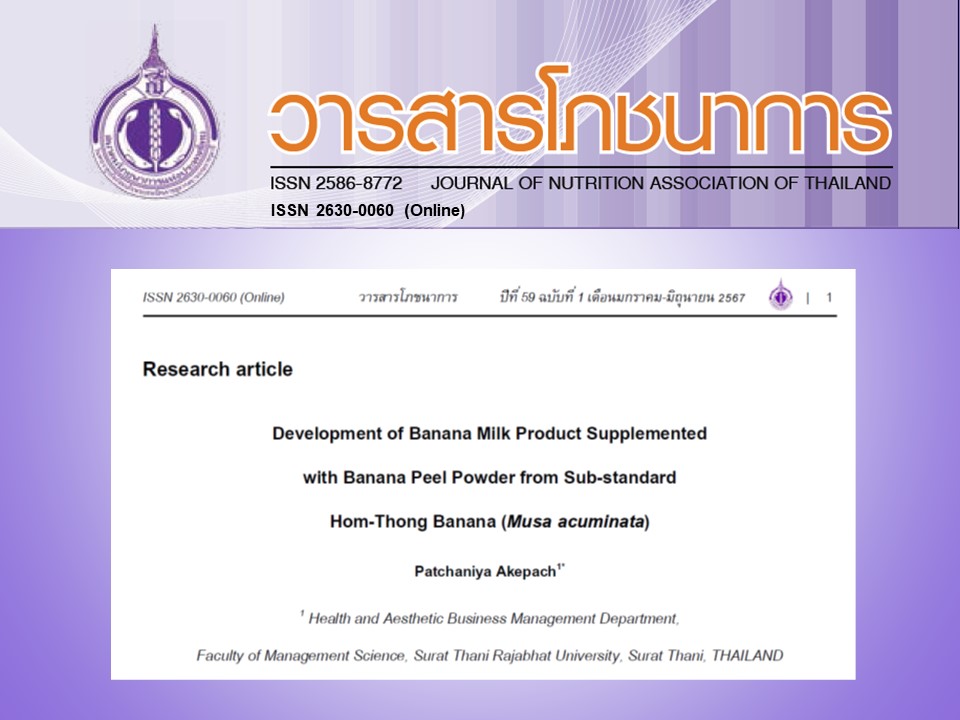Development of Banana Milk Product Supplemented with Banana Peel Powder from Sub-standard Hom-Thong Banana (Musa acuminata)
Keywords:
Sub-standard Hom-Thong banana, Banana peel, Banana peel powder, Banana milk drinkAbstract
Bananas are classified as an economic crop in ASEAN. Currently, Thailand's Hom-Thong bananas are marketed both within the country and abroad due to the production of plants for export. Produce with good quality will be selected for export while that does not meet the standard for export is thrown away. When graded bananas are processed into products, there will be leftovers such as peels that are discarded as waste, which is a serious problem for farmers. Therefore, studying the economic utilization of bananas and banana waste, whether it is simple processing that farmers can do themselves or industrially to add value. It is another way to create careers and increase income for farmers. The objective of this research was to study the amount of sub-standard Hom-Thong banana peels in banana milk products. The ratio of banana pulp, milk powder, and water (grams per 100 grams) was studied using the experimental design program to design a set of experiments for Principal Component Analysis (PCA) with a multivariate technique for linear summation. Then, the best ingredient formula was used to develop a banana milk product fortified with banana peel powder at three levels: 0, 0.25, and 0.5 grams per 100 grams. The results of consumer acceptability using 9-points hedonic scale test by using 10 trained panelists showed that banana milk products with added banana peel powder equal to 0.5 grams per 100 grams (banana pulp, milk powder, water, and banana peel powder were 12.19, 29.35, 57.96, and 0.5 grams per 100 grams, respectively) had the overall acceptability score of 8 (like very much). While the experimental set with added banana peel powder of 0.25 grams per 100 grams (banana pulp, powdered milk, water, and banana peel powder were 12.22, 29.43, 58.1, and 0.25 grams per 100 grams, respectively) had moderate acceptability of color when compared to other experimental sets. The selected banana milk formula contained 0.5 grams of banana peel powder per 100 grams providing dietary fiber 0.75 grams per 1 serving (a box of 150 grams) which accounts for 0.8 percent of the recommended daily intake.
References
Reddy N, Yang Y. Biofibers from agricultural byproducts. Trends Biotechnol 2005;23:22-7.
Xue L, Liu G, Parfitt J, Liu X, Herpem EV, Stenmarck A, Cheng S. Missing food, missing data? A critical review. Environ Sci Technol 2017;51:6618-33.
Food and Agriculture Organization. Food Wastage Footprint: Impacts on Nutritional Resource. Rome: Food and Agriculture Organization; 2013.
Vu HT, Scarlett CJ, Voung QV. Phenolic compounds within banana peel and their potential uses: A review. J Funct Foods 2018;40:238-48.
Padam BS, Tin HS, Chye FY, Abdullah, MI. Banana by-products: an under-utilized renewable food biomass with great potential. J Food Sci Technol 2014;51:3527-45.
Wachirasiri P, Julakarangka S, Wanlapa S. The effects of banana peel preparations on the properties of banana peel dietary fibre concentrate. Songklanakarin J Sci Tech 2009;31:605-11.
Pyar H, Peh KK. Chemical Compositions of Banana Peels (Musa sapientum) Fruit cultivated in Malaysia using proximate analysis. Res J Chem Environ 2018;22:108-13.
ปิยนุสร์ น้อยด้วง, ปัทมา คล้ายจันทร์. การผลิตโยเกิร์ตกล้วยหอม. วารสารเทคโนโลยีการอาหาร มหาวิทยาลัยสยาม 2547;1:27-31.
กฤติยา เขื่อนเพชร, เปี่ยมสุข สุวรรณกูฏ, รวิพร พลพืช, รวิภา จารุอารยนันท์. การพัฒนาผลิตภัณฑ์เครื่องดื่มกล้วยหอมทองผงเพื่อสุขภาพ. วารสารวิทยาศาสตร์และเทคโนโลยี 2018;27:1024-37.
Rodrıguez R, Ana J, Juan FB. Dietary fibre from vegetable products as source of functional ingredients. Trends Food Sci Technol 2006;17:3–15.
สำนักอาหาร. ประกาศกระทรวงสาธารณสุข (ฉบับที่ 213) พ.ศ. 2543 เรื่อง แยม เยลลี่ และมาร์มาเลดในภานชนะบรรจุที่ปิดสนิท. กรุงเทพฯ: สำนักงานคณะกรรมการอาหารและยา; 2548.
Larrauri JA, Rupérez P, Borroto B, Saura-Calixto F. Mango peels as a new tropical fiber: preparation and characterization. Lebensm Wiss Technol 1966;29:729-33.
Chantaro P, Devahastin S, Chiewchan N. Production of antioxidant high dietary fiber powder from carrot peel, LWT-Food Sci Technol 2008;41:1987-94.
Figuerola F, Hurtado ML, Estévez AM, Chiffelle I, Asenjo F. Fibre concentrates from apple pomace and citrus peel as potential fiber sources for food enrichment. Food Chem 2005;9:395-401.
Wuttipalakorn P, Srichumpuang W, Chiewchan N. Effects of pretreatment and drying on composition and bitterness of high dietary fiber powder from lime residues. Dry Technol 2009;27:133-42.
Tanongkankit Y, Chiewchan N, Devahastin S. Effects of processing on antioxidants and their activity in dietary fiber powder from cabbage outer leaves. Dry Technol 2010;28:1063-71.
Kader AA. Postharvest Technology of Horticultural Crops. 5th ed. California: The University of California Agricultural and Natural Resources; 2011.
ศศิภา เต็กอวยพร. การพัฒนาระบบวิเคราะห์เชิงภาพถ่ายเพื่อตรวจตดิตามคุณภาพของผลิตภัณฑ์ขนมปังกรอบ [วิทยานิพนธ์ปริญญาวิทยาศาสตร์มหาบัณฑิต]. กรุงเทพฯ: มหาลัยศิลปากร; 2554.
Association of Official Agriculture Chemists. Official Methods of Analysis of AOAC International. Maryland: AOAC International; 2023, Method number 985.29, 991.43, and 991.43.

Downloads
Published
How to Cite
Issue
Section
License
Upon acceptance of an article, copyright is belonging to the Nutrition Association of Thailand.


